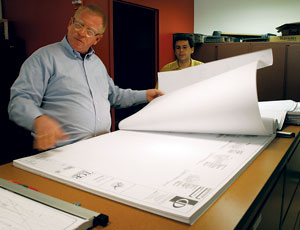A case challenging the patentability of business methods will be heard by the U.S. Supreme Court in December. The outcome may rock innovators and inventors in the construction industry.
Bilski v. Doll is Bernard Bilski’s last appeal. Doll is John Doll, acting director of the U.S. patent office, which has rejected Bilski’s patent for a method to hedge risks in commodities trading. The case would normally be a far cry from construction, except the language of the most recent rejection, by the U.S. Court of Appeals for the Federal Circuit in October, added a new bar for any business-method patent application to pass: It must either be tied to a machine or transform one article into another to be eligible.

“It means every time you invent something you are not going to be able to protect it...unless you have some machine involved or some actual physical structure involved,” says Larry Coats, a partner at Cary, N.C.–based intellectual-property law firm Coats & Bennett.
“This case has wide implications in computer software and business methods,” says J. Michael Jakes, a partner at the Washington, D.C., intellectual-property law firm of Finnegan Henderson, which represents Bilski.
Apparently the appeals court thought so too. It convened 12 of its 15 judges instead of the usual three to hear arguments and issue a rare en banc ruling to judicially create the machine-or-transformation test, a standard that had not been invoked before. The court said it was drawing on Supreme Court precedents, then ruled that Bilski’s method did not meet the test and was therefore not patentable.
Prior to Bilski, the patent office had relied on a 1998 Court of Appeals ruling in State Street Bank & Trust Co. v. Signature Financial Group, Inc., which held business methods to a lower standard of producing a “useful, concrete and tangible result.” Coats says he suspects the patent office has been deluged with applications ever since and wants a stricter test.
“If Bilski is upheld, it would invalidate tens of thousands of patents,” says Coats. “That’s a huge impact right there.”
Others support the ruling. Chicago construction business-method consultant and software developer Ben Suter says he thinks patent restrictions were lax before Bilski and believes many patents were awarded without proof the inventor could turn an idea into a practical and useful tool—whether a process or physical machine.
“There is a big gap between a concept and turning it into reality,” he says. “Within the context of engineering and construction, this should keep us honest, helping to focus on methods that have a direct impact on what we set out to build.”
Coats says the machine-or-transformation test will make applicants write extremely detailed, narrow patent claims, which will yield patents with extremely limited protection. Patents for business methods, even such as those using machines to improve information flow on a jobsite, are at risk. “For that, you’d have to write a patent claim broad enough to cover a laptop, PDA and whatever else it uses,” he says. “You’d have to describe the database, the architecture of the database, how a search is performed, how the documents are available and how the plumber or electrician is going to get it on that part of a site.”
Patent holder, inventor and concrete subcontractor David Hudgens, president of Accu-Crete, Alexandria, Va., worries Bilski will slow innovation in an industry that sorely needs it. For years, he has experimented with building information modeling and display and communications technology, seeking ways to improve the accuracy, completeness and delivery of information to workers in the field. It all revolves around inventing techniques and processes to improve project delivery. The Bilski ruling hits him hard.
“This is the worst thing,” he says. “This just kills it. It’s nuts. The way contractors make money is they perfect and make more efficient different methodologies—and they should be able to patent them,” Hudgens says.
Hudgens holds technology patents for hardhats with built-in communications and data linking hardware to take job data to the field. He’s appealing a third patent application for a GPS interface to make job data location-specific.
“I use a lot of machines, and for a lot of the things I don’t,” says Hudgens, who has a forthcoming idea to streamline and optimize project delivery that he’d like to patent someday. It is a system that links multiple trades in one data coordination methodology, which teams coming together could license on a project-by-project basis.
It is innovation like this, if fully developed and realized, that should be eligible for patents, Suter agrees. But, unlike Hudgens, he thinks the Circuit Court’s machine-or-transformation test could help ensure they are fully realized by taking a more rigid line on patentability. “A more conservative approach to granting business method patents ought to favor companies who excel at recognizing good ideas, developing and implementing them, and capitalizing when a real invention is achieved,” Suter wrote in a letter to ENR.
Supreme Court May Help or Hurt
Ultimately, the Supreme Court’s action in Bilski case may establish exactly, as Jakes puts it, “what you can patent.” Alternatively, both sides know that without careful wording, the Court could also easily complicate an already murky area of patent law.
Attorneys such as Tom Miller of Michael Best & Friedrich, an IP firm out of Chicago, Ill. believe that Bilski has already prepared the patent community for more cautious patent-claim writing. He represents Textura Corporation, a company that provides construction payment management software for large projects, and is guiding them through the process for 11 U.S. pending patents. Textura also has 24 foreign patents in process.
It’s a matter of making sure that there is enough technology involved to get a patent,” Miller says, which effectively protects his clients from something he calls “the naked business method,” or an abstract process. He’s been following Bilski since before the Federal Circuit Court’s decision and knew to adjust patent applications accordingly.
Miller doesn’t think Bilski will be overturned, but “will be modified in some respect.” He says there is a chance the Supreme Court will reject Bilski’s method as patentable subject matter, but can repeal the machine-or-transformation test because it may overstep Congressional intent and the Court’s own precedent.
| At 7:30 a.m., on July 22, an employee of Accu-Crete Corp., Alexandria, Va., died on a jobsite, apparently after suffering a heart attack out of view of fellow workers. His name is being withheld pending notification of next of kin. Company president David Hudgens says he believes faster adoption of innovative technology could have helped save the man’s life. A hardhat or hand-held computer with a health-monitoring biometric feedback system, for example, could have warned the employee of his elevated risk. “It would have told him ‘you don’t need to be working today...your heart is giving you trouble,’” says Hudgens. “It didn’t have to happen. He just went to the back of the yard and didn’t come back.” A patent for a hardhat with electronic circuitry, awarded to Hudgens in November 2007, covers a hardhat with electronic circuitry that allows radio frequency tracking of individual employees on a jobsite. The patent already covers inclusion of biometric sensors to ensure the hats are being worn—and worn by the individuals to whom they were issued. That information could then be used in many ways by job site managers, including by providing a way to ensure that employees are properly certified for the activities they are engaged in. Health-monitoring feedback would be another use of the technology. A patent whose denial Hudgens now is appealing would support a business process for electronically connecting workers on the jobsite to task-relevant, time-sensitive project data delivered on Game Boy or PDA-type devices. A health monitoring feedback system could be incorporated in a user authentication system. Hudgens decries the slow pace and difficulty of the patent approval process in the U.S. and says it compares unfavorably with the way the patent system works in China, where he says he has been spending four or five months a year observing industry advances. “The whole thing I have been fighting for five years is a 90-day process for them,” he says. |



Post a comment to this article
Report Abusive Comment